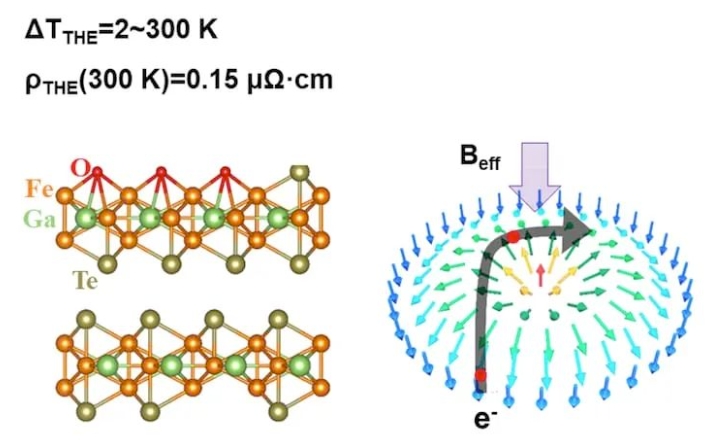博文
《物理世界》研究进展: 具有超宽温域、低电流可调性的巨二维斯格明子拓扑霍尔效应
|

EXPRESS LETTER
Giant 2D Skyrmion Topological Hall Effect with Ultrawide Temperature Window and Low-Current Manipulation in 2D Room-Temperature Ferromagnetic Crystals
Gaojie Zhang (张高节), Qingyuan Luo (罗清源), Xiaokun Wen (文晓琨), Hao Wu (武浩), Li Yang (杨丽), Wen Jin (靳雯), Luji Li (李路吉), Jia Zhang (张佳), Wenfeng Zhang (张文峰), Haibo Shu (舒海波), and Haixin Chang (常海欣)
Chin. Phys. Lett. 2023 40 (11): 117501
DOI: 10.1088/0256-307X/40/11/117501
研究快讯
具有超宽温域、低电流可调性的巨二维斯格明子拓扑霍尔效应
首次在自然氧化的二维室温铁磁晶体Fe3GaTe2-x中观察到具有超宽温域、低电流可调性的巨二维斯格明子拓扑霍尔效应(Giant 2D skyrmion topological Hall effect),为基于电流可调的室温二维拓扑霍尔效应的自旋电子器件的实际应用开辟了道路。
This work has been highlighted in a research update published in Physics World.
Giant skyrmion topological Hall effect appears in a two-dimensional ferromagnetic crystal at room temperature
Isabelle Dumé

Stable skyrmions: First-principles calculations of the skyrmion-stabilizing Dzyaloshinskii–Moriya interaction in pristine (bottom) and oxidized (top) Fe3GaTe2-x enabled the team to understand why the skyrmions that form (right) are so robust. (Courtesy: H Chang)
Researchers in China have produced a phenomenon known as the giant skyrmion topological Hall effect in a two-dimensional material using only a small amount of current to manipulate the skyrmions responsible for it. The finding, which a team at Huazhong University of Science and Technology in Hubei observed in a ferromagnetic crystal discovered in 2022, comes about thanks to an electronic spin interaction known to stabilize skyrmions. Since the effect was apparent at a wide range of temperatures, including room temperature, it could prove useful for developing two-dimensional topological and spintronic devices such as racetrack memory, logic gates and spin nano-oscillators.
Skyrmions are quasiparticles with a vortex-like structure, and they exist in many materials, notably magnetic thin films and multilayers. They are robust to external perturbations, and at just tens of nanometres across, they are much smaller than the magnetic domains used to encode data in today’s hard disks. That makes them ideal building blocks for future data storage technologies such as “racetrack” memories.
Skyrmions can generally be identified in a material by spotting unusual features (for example, abnormal resistivity) in the Hall effect, which occurs when electrons flow through a conductor in the presence of an applied magnetic field. The magnetic field exerts a sideways force on the electrons, leading to a voltage difference in the conductor that is proportional to the strength of the field. If the conductor has an internal magnetic field or magnetic spin texture, like a skyrmion does, this also affects the electrons. In these circumstances, the Hall effect is known as the skyrmion topological Hall effect (THE).
For quasiparticles to be useful as platforms for two-dimensional (2D) spintronic devices, a large THE is highly desirable, but the skyrmions also need to be stable over a wide temperature range and easy to manipulate using small electric currents. Until now, making skyrmions with all these properties has been difficult, says team leader Haixin Chang.
“Most known skyrmions and the THE are stabilized in only a narrow temperature window either below or above room temperature and require high critical current manipulation,” he tells Physics World. “It is still elusive and very challenging to achieve a large THE with both a wide temperature window up to room temperature and a low critical current for skyrmion manipulation, especially in 2D systems suitable for electronic and spintronic integrations.”
Robust 2D skyrmion THE
Chang and colleagues are now reporting a 2D skyrmion that seems to fit the bill. Not only does the THE they observe remain robust over a temperature window spanning three orders of magnitude, it is also very large, measuring 5.4 µΩ·cm at 10 K and 0.15 µΩ·cm at 300 K. This is between one and three orders of magnitude bigger than previously reported room-temperature 2D skyrmion systems. And that is not all: the researchers found that their 2D skyrmion THE can be controlled with a low critical current density of around just 6.2×105 A·cm-2. The researchers say this was possible due to the high-quality samples they fabricated (which have a finely-controllable 2D ferromagnetism), plus their precise quantitative analyses of the THE electrical measurements.
Chang thinks the team’s work paves the way for room-temperature electrically-controlled 2D THE and skyrmion-based practical spintronic and magnetoelectronic devices. “Room-temperature electrical detection and manipulation of skyrmions by the topological Hall effect are promising for next-generation low-power spintronic devices,” he says.
Where the effect comes from
The team also delved into possible reasons for the robust giant 2D skyrmion THE they observed. Based on their theoretical calculations, they found that the natural oxidation of the Fe3GaTe2-𝑥 ferromagnetic crystal they studied enhanced a known skyrmion-stabilizing magnetic effect called the 2D interfacial Dzyaloshinskii–Moriya interaction (DMI). Hence, by carefully controlling the natural oxidation and thickness of the Fe3GaTe2-𝑥 crystal, they formed a reliable oxidation interface with a sizeable interfacial DMI, and showed that they were able to produce a robust 2D skyrmion THE within a wide temperature window. This is no easy task because excessive oxidation can cause the structure of the crystal to degrade, while insufficient oxidation makes it hard to form a large interfacial DMI. Both extremes tend to hinder the formation of skyrmions and thus the THE.
“Our group has been studying magnetism in 2D crystals since 2014 and we have developed many new magnetic crystals, including the one studied in this work,” says Chang. “Both skyrmions and the topological Hall effect are very interesting topological physical phenomena that are typically observed in some magnetic systems, but which have a lot of intrinsic limitations for practical applications.
“We conducted this study to try and overcome these limitations in traditional magnetic materials.”
The researchers say their work, which is detailed in Chinese Physics Letters, could lead to a general methodology for tuning 2D DMI for spin transport control in 2D ferromagnetic crystals. “It also proves that oxidation can be used to induce a giant 2D THE much better than heavy metal and other so-called strong spin-orbit coupling compounds traditionally employed,” Chang says.
The Huazhong team is now looking into making racetrack memories and logic gate devices based on their 2D skyrmion systems for high-speed and high-density data storage, logic operation and what the researchers call “new-concept quantum computation”.
© Copyright 2023 IOP Publishing Ltd
研究快讯集锦
共线反铁磁中的手性狄拉克费米子
三类Kagome结构的高通量计算及热力学稳定性评估
利用深度学习预测复杂网络的热导特性
La3Ni2O7高温超导电性的微观有效模型及密度矩阵重正化群研究
活性转子系统的局域转动阻塞和多级超均匀性
拓扑半金属磷化钼中的巨大非线性光学效应
具有超宽温域、低电流可调性的巨二维斯格明子拓扑霍尔效应
超离子态冰相变导致的反常热输运
FeGe中的电子关联诱导的电荷密度波
等离子体输运中的扩散拓扑物相
用于同质架构储备池计算的莫尔突触晶体管
基于非厄米趋肤效应的二维传热调控
钪刷新元素超导温度
通过梯度下降法实现声子晶体的逆向设计
几何热电泵浦:不同于塞贝克和热释电的新型能量效应
二维AlH2单层:零维电子态与超导电性共存
阿秒X射线俄歇电子谱学
二维材料中实现声子聚焦
石墨烯花状缺陷诱导的原子尺度谷滤波效应
通过电偶极覆盖层调控范德华材料层间相互作用
通过 H 的表面饱和实现cg-N在环境条件下的稳定存在
可在零下100 ℃工作的锂离子电池
基于电子体系的高随机性高稳定性的无后处理量子随机数发生器
二维半导体包覆和范德华接触的晶体管构筑方法

点此浏览所有Express Letters
CPL Express Letters栏目简介
为了保证重要研究成果的首发权和显示度,CPL于2012年6月开设了Express Letters栏目。此栏目发表速度快,学术质量高。截至2020年底,平均每篇被引用约20次,已经在国内物理学界建立起良好口碑与声望,来稿数量不断增加。

物理世界3物理世界 · 目录上一篇阅读原文
https://blog.sciencenet.cn/blog-3426263-1415314.html
上一篇:研究快讯 | 共线反铁磁中的手性狄拉克费米子
下一篇:研究快讯 | VASP2KP: 通过第一性方法计算kp模型和朗德g因子